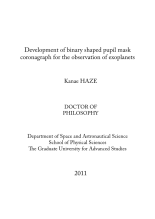Development of binary shaped pupil mask coronagraph for the observation of exoplanets 太陽系外惑星観測に向けたバイナリ瞳マスクコロナグラフの開発
Access this Article
Search this Article
Author
Bibliographic Information
- Title
-
Development of binary shaped pupil mask coronagraph for the observation of exoplanets
- Other Title
-
太陽系外惑星観測に向けたバイナリ瞳マスクコロナグラフの開発
- Author
-
櫨, 香奈恵
- Author(Another name)
-
ハゼ, カナエ
- University
-
総合研究大学院大学
- Types of degree
-
博士 (理学)
- Grant ID
-
甲第1488号
- Degree year
-
2012-03-23
Note and Description
博士論文
The direct detection and spectroscopy of extra-solar planets (exoplanets) is essential for understanding how planetary systems were born, how they evolve, and, ultimately, for finding biological signatures on these planets. The enormous contrast in luminosity between the central star and a planet presents the primary difficulty in the direct observation of exoplanets. For example, if the solar system is observed from a distance, the expected contrast between the central star and the planet is ~10-10 in the visible light region and ~10-6 in the mid-infrared region. Therefore, the development of stellar coronagraphs, which can improve the contrast between the star and the planet, is needed. Of the various kinds of coronagraph, we have focused on a binary-shaped pupil mask coronagraph. The reasons for using this coronagraph are that it is robust against pointing errors, it can, in principal, be used to make observations over a wide wavelength range and it is relatively simple. Also, the adoption of a binary-shaped pupil mask coronagraph for Space Infrared telescope for Cosmology and Astrophysics (SPICA) is considered. We conducted a number of coronagraphic experiments in a vacuum chamber using a checkerboard mask, which is a kind of binary-shaped pupil mask, without active wavefront control. This study is unique and important in that it includes not only the tasks necessary to make the coronagraph fit for practical use, but also tests to verify its use for actual coronagraphic observations. The three kinds of experiment carried out for this study are described below. 1. In space telescopes, the Wavefront error (WFE) caused by imperfections in the optics is an important limiting factor in the contrast of a coronagraph. Subtracting the Point Spread Function (PSF) is beneficial in that it removes any static WFE, and achieves a higher contrast than that in the raw image. Subtraction of the PSF is available in the direct observation of exoplanets using space telescopes, which helps to improve high-contrast observations. We evaluated how much the PSF subtraction contributed to the high contrast observation by subtracting the images obtained through the coronagraph. We improved the temperature stability by installing the coronagraph optics in a vacuum chamber, controlling the temperature of the optical bench, and covering the vacuum chamber with thermal insulation layers. With a He-Ne laser at a wavelength of 632.8nm, a contrast of 2.3×10-7 was obtained for the raw coronagraphic image and a contrast of 1.3×10-9 was achieved after subtraction of the PSF. Thus, an improvement of around two orders of magnitude in contrast was achieved by subtracting the PSF. 2. A He-Ne laser was employed as the light source in the previous experiments. On the other hand, the binary-shaped pupil mask coronagraph should, in principal, be used for observations over a wide range of wavelengths. Actual observations are made over a wavelength band, and it would be profitable to make observations using multiple bands. We carried out multi-color/broadband experiments using Super luminescent Light Emitting Diodes (SLEDs) with center wavelengths of 650nm, 750nm, 800nm and 850nm in order to demonstrate the coronagraph’s potential for making more realistic observations. We achieved contrasts of 3.1×10-7, 1.1×10-6, 1.6×10-6 and 2.5×10-6 at the bands centered on 650nm, 750nm, 800nm and 850nm, respectively. We experimentally proved the multi-color/broadband coronagraph. 3. However, the current checker-board mask with a glass substrate has the problems of light loss due to transmission, ghosting from residual reflectance and a slightly different refractive index for each wavelength. Therefore, we developed a new free-standing sheet metal mask without the need for a substrate. The free-standing mask can be used for infrared observations which have a great advantage over visible light observations in that the contrast between the star and the planet is much less. As a result, with the He-Ne laser and a free-standing mask, a contrast of 1.0×10-7 was achieved for the raw coronagraphic image by areal averaging of all the observed dark regions. Speckles are the major limiting factor. A similar significant improvement in contrast was demonstrated with the free-standing mask as with the substrate mask. We demonstrated that subtraction of the PSF is potentially beneficial for improving the contrast of a binary-shaped pupil mask coronagraph, that this coronagraph can provide a significant improvement in contrast with multi-color/broadband light sources, and that the new free-standing mask for practical use provides superior performance of improving contrast. We performed the tasks necessary to make the coronagraph fit for practical use. In conclusion, we carried out verification tests on the binary-shaped pupil mask coronagraph for actual coronagraphic observations. In this study we developed the study of the checker-board mask coronagraph and overcame difficulties encountered in practical observations by satellite. Consequently, the results of this study suggest that the binary-shaped pupil mask coronagraph can be applied to coronagraphic observations by SPICA and other telescopes.
総研大甲第1488号
資料番号: SA8000901000

